Research Project: Customer Loyalty, Reward Schemes, and Behavior
VerifiedAdded on 2020/10/22
|25
|5353
|154
Report
AI Summary
This research project delves into the analysis of customer behavior concerning loyalty cards and reward schemes within organizations. The study begins with an overview, background, aims, objectives, research questions, rationale, and significance of the study. Chapter 2 conducts a thorough literature review, exploring the concept of consumer loyalty, relevant theories, and the role of loyalty cards and reward schemes. The methodology chapter outlines the research philosophy, approach, design, data collection methods, and ethical considerations. The report then presents data analysis in Chapter 4, followed by recommendations and conclusions in Chapter 5. The research aims to understand the impact of loyalty programs on customer behavior, identify key issues, and provide actionable recommendations for enhancing customer retention and loyalty.

Research Project
Paraphrase This Document
Need a fresh take? Get an instant paraphrase of this document with our AI Paraphraser
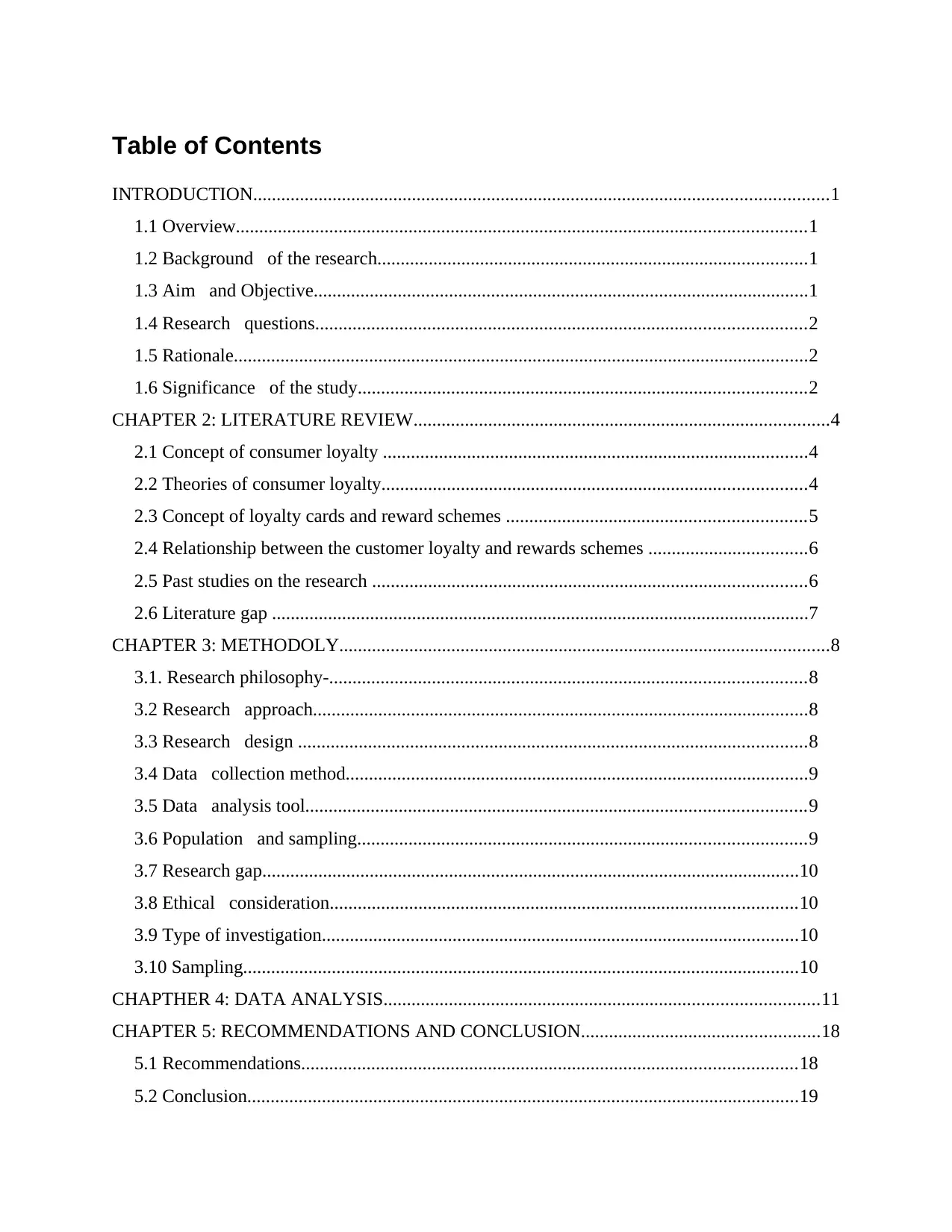
Table of Contents
INTRODUCTION...........................................................................................................................1
1.1 Overview..........................................................................................................................1
1.2 Background of the research............................................................................................1
1.3 Aim and Objective..........................................................................................................1
1.4 Research questions.........................................................................................................2
1.5 Rationale...........................................................................................................................2
1.6 Significance of the study................................................................................................2
CHAPTER 2: LITERATURE REVIEW.........................................................................................4
2.1 Concept of consumer loyalty ...........................................................................................4
2.2 Theories of consumer loyalty...........................................................................................4
2.3 Concept of loyalty cards and reward schemes ................................................................5
2.4 Relationship between the customer loyalty and rewards schemes ..................................6
2.5 Past studies on the research .............................................................................................6
2.6 Literature gap ...................................................................................................................7
CHAPTER 3: METHODOLY.........................................................................................................8
3.1. Research philosophy-......................................................................................................8
3.2 Research approach..........................................................................................................8
3.3 Research design .............................................................................................................8
3.4 Data collection method...................................................................................................9
3.5 Data analysis tool...........................................................................................................9
3.6 Population and sampling................................................................................................9
3.7 Research gap...................................................................................................................10
3.8 Ethical consideration....................................................................................................10
3.9 Type of investigation......................................................................................................10
3.10 Sampling.......................................................................................................................10
CHAPTHER 4: DATA ANALYSIS.............................................................................................11
CHAPTER 5: RECOMMENDATIONS AND CONCLUSION...................................................18
5.1 Recommendations..........................................................................................................18
5.2 Conclusion......................................................................................................................19
INTRODUCTION...........................................................................................................................1
1.1 Overview..........................................................................................................................1
1.2 Background of the research............................................................................................1
1.3 Aim and Objective..........................................................................................................1
1.4 Research questions.........................................................................................................2
1.5 Rationale...........................................................................................................................2
1.6 Significance of the study................................................................................................2
CHAPTER 2: LITERATURE REVIEW.........................................................................................4
2.1 Concept of consumer loyalty ...........................................................................................4
2.2 Theories of consumer loyalty...........................................................................................4
2.3 Concept of loyalty cards and reward schemes ................................................................5
2.4 Relationship between the customer loyalty and rewards schemes ..................................6
2.5 Past studies on the research .............................................................................................6
2.6 Literature gap ...................................................................................................................7
CHAPTER 3: METHODOLY.........................................................................................................8
3.1. Research philosophy-......................................................................................................8
3.2 Research approach..........................................................................................................8
3.3 Research design .............................................................................................................8
3.4 Data collection method...................................................................................................9
3.5 Data analysis tool...........................................................................................................9
3.6 Population and sampling................................................................................................9
3.7 Research gap...................................................................................................................10
3.8 Ethical consideration....................................................................................................10
3.9 Type of investigation......................................................................................................10
3.10 Sampling.......................................................................................................................10
CHAPTHER 4: DATA ANALYSIS.............................................................................................11
CHAPTER 5: RECOMMENDATIONS AND CONCLUSION...................................................18
5.1 Recommendations..........................................................................................................18
5.2 Conclusion......................................................................................................................19

REFERENCES..............................................................................................................................20
APPENDIX....................................................................................................................................21
APPENDIX....................................................................................................................................21
⊘ This is a preview!⊘
Do you want full access?
Subscribe today to unlock all pages.

Trusted by 1+ million students worldwide
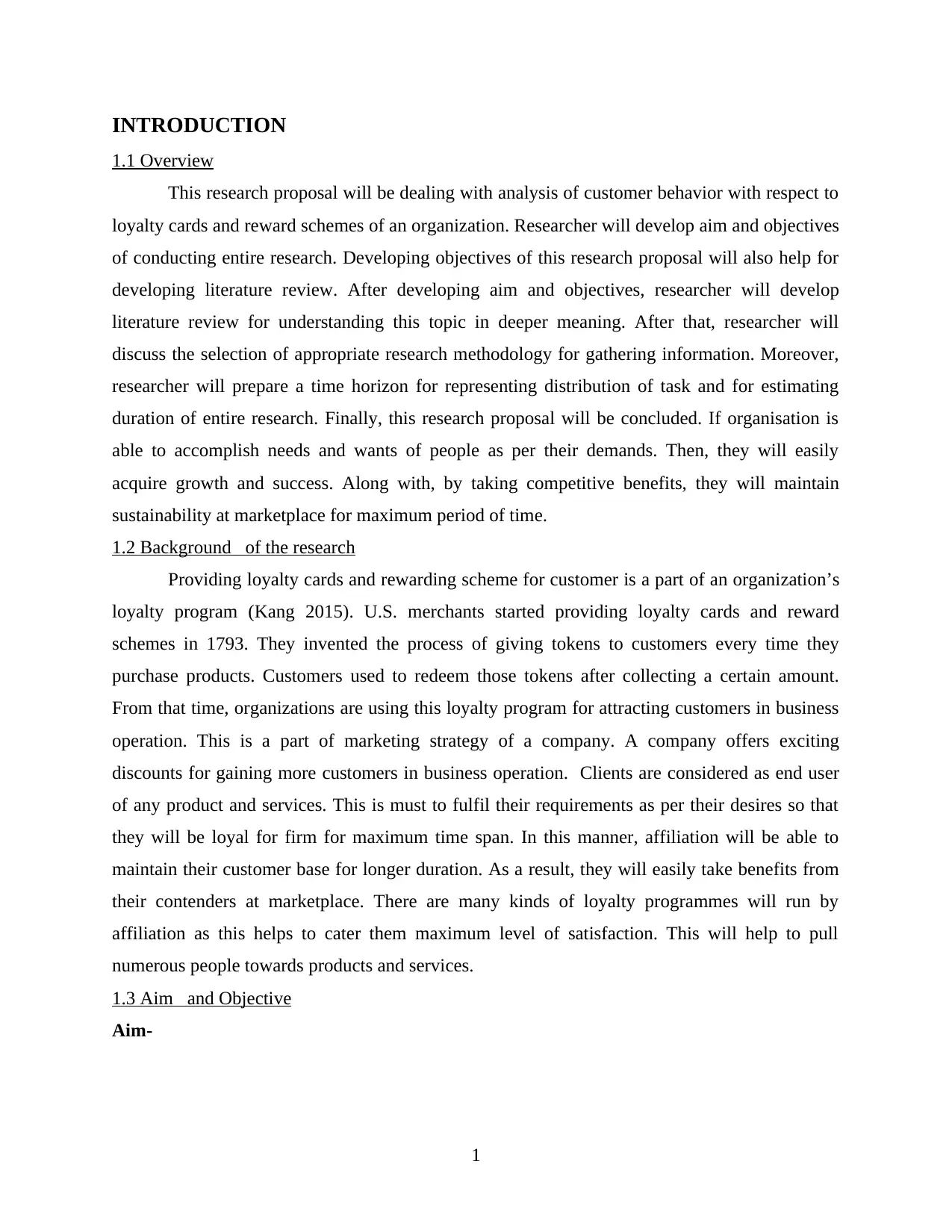
INTRODUCTION
1.1 Overview
This research proposal will be dealing with analysis of customer behavior with respect to
loyalty cards and reward schemes of an organization. Researcher will develop aim and objectives
of conducting entire research. Developing objectives of this research proposal will also help for
developing literature review. After developing aim and objectives, researcher will develop
literature review for understanding this topic in deeper meaning. After that, researcher will
discuss the selection of appropriate research methodology for gathering information. Moreover,
researcher will prepare a time horizon for representing distribution of task and for estimating
duration of entire research. Finally, this research proposal will be concluded. If organisation is
able to accomplish needs and wants of people as per their demands. Then, they will easily
acquire growth and success. Along with, by taking competitive benefits, they will maintain
sustainability at marketplace for maximum period of time.
1.2 Background of the research
Providing loyalty cards and rewarding scheme for customer is a part of an organization’s
loyalty program (Kang 2015). U.S. merchants started providing loyalty cards and reward
schemes in 1793. They invented the process of giving tokens to customers every time they
purchase products. Customers used to redeem those tokens after collecting a certain amount.
From that time, organizations are using this loyalty program for attracting customers in business
operation. This is a part of marketing strategy of a company. A company offers exciting
discounts for gaining more customers in business operation. Clients are considered as end user
of any product and services. This is must to fulfil their requirements as per their desires so that
they will be loyal for firm for maximum time span. In this manner, affiliation will be able to
maintain their customer base for longer duration. As a result, they will easily take benefits from
their contenders at marketplace. There are many kinds of loyalty programmes will run by
affiliation as this helps to cater them maximum level of satisfaction. This will help to pull
numerous people towards products and services.
1.3 Aim and Objective
Aim-
1
1.1 Overview
This research proposal will be dealing with analysis of customer behavior with respect to
loyalty cards and reward schemes of an organization. Researcher will develop aim and objectives
of conducting entire research. Developing objectives of this research proposal will also help for
developing literature review. After developing aim and objectives, researcher will develop
literature review for understanding this topic in deeper meaning. After that, researcher will
discuss the selection of appropriate research methodology for gathering information. Moreover,
researcher will prepare a time horizon for representing distribution of task and for estimating
duration of entire research. Finally, this research proposal will be concluded. If organisation is
able to accomplish needs and wants of people as per their demands. Then, they will easily
acquire growth and success. Along with, by taking competitive benefits, they will maintain
sustainability at marketplace for maximum period of time.
1.2 Background of the research
Providing loyalty cards and rewarding scheme for customer is a part of an organization’s
loyalty program (Kang 2015). U.S. merchants started providing loyalty cards and reward
schemes in 1793. They invented the process of giving tokens to customers every time they
purchase products. Customers used to redeem those tokens after collecting a certain amount.
From that time, organizations are using this loyalty program for attracting customers in business
operation. This is a part of marketing strategy of a company. A company offers exciting
discounts for gaining more customers in business operation. Clients are considered as end user
of any product and services. This is must to fulfil their requirements as per their desires so that
they will be loyal for firm for maximum time span. In this manner, affiliation will be able to
maintain their customer base for longer duration. As a result, they will easily take benefits from
their contenders at marketplace. There are many kinds of loyalty programmes will run by
affiliation as this helps to cater them maximum level of satisfaction. This will help to pull
numerous people towards products and services.
1.3 Aim and Objective
Aim-
1
Paraphrase This Document
Need a fresh take? Get an instant paraphrase of this document with our AI Paraphraser
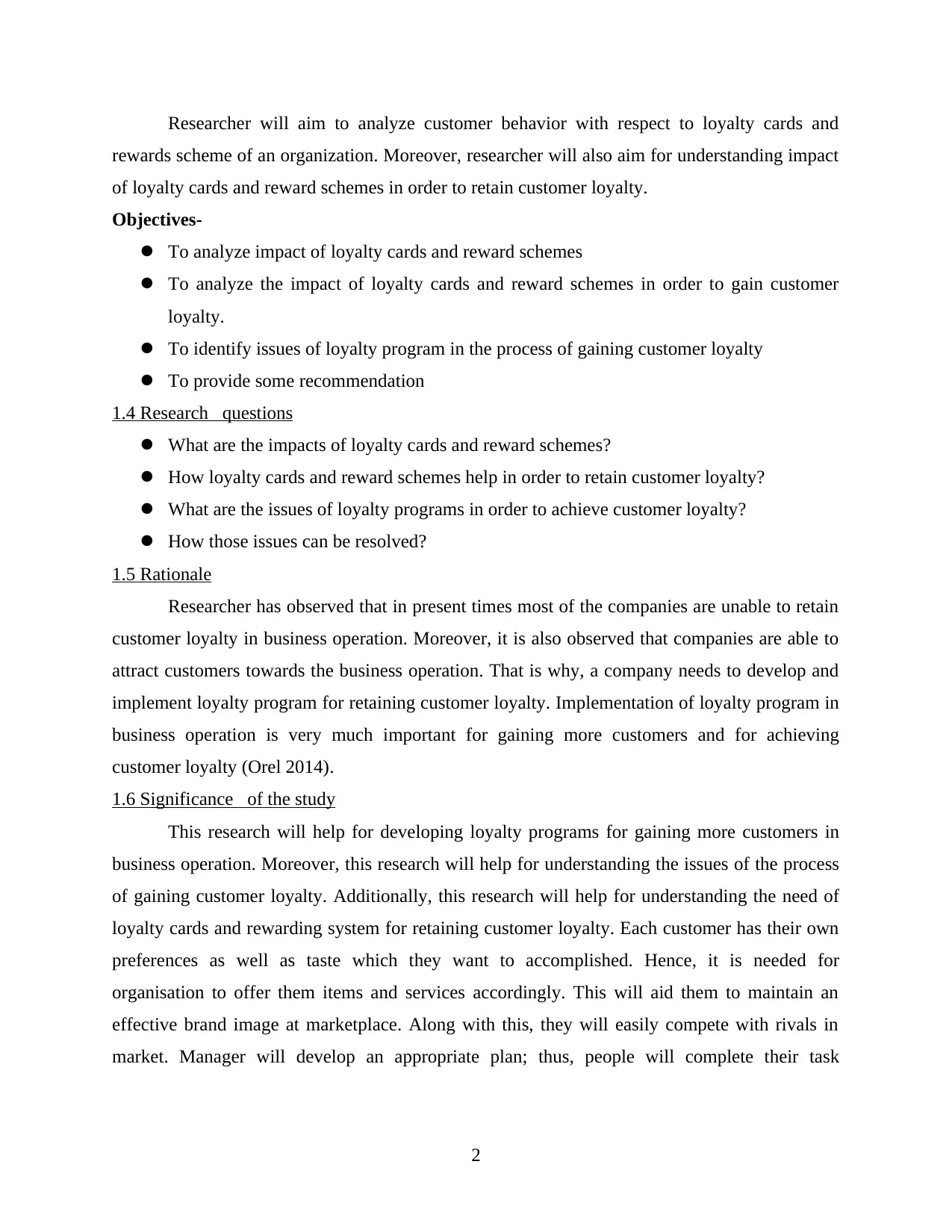
Researcher will aim to analyze customer behavior with respect to loyalty cards and
rewards scheme of an organization. Moreover, researcher will also aim for understanding impact
of loyalty cards and reward schemes in order to retain customer loyalty.
Objectives-
To analyze impact of loyalty cards and reward schemes
To analyze the impact of loyalty cards and reward schemes in order to gain customer
loyalty.
To identify issues of loyalty program in the process of gaining customer loyalty
To provide some recommendation
1.4 Research questions
What are the impacts of loyalty cards and reward schemes?
How loyalty cards and reward schemes help in order to retain customer loyalty?
What are the issues of loyalty programs in order to achieve customer loyalty?
How those issues can be resolved?
1.5 Rationale
Researcher has observed that in present times most of the companies are unable to retain
customer loyalty in business operation. Moreover, it is also observed that companies are able to
attract customers towards the business operation. That is why, a company needs to develop and
implement loyalty program for retaining customer loyalty. Implementation of loyalty program in
business operation is very much important for gaining more customers and for achieving
customer loyalty (Orel 2014).
1.6 Significance of the study
This research will help for developing loyalty programs for gaining more customers in
business operation. Moreover, this research will help for understanding the issues of the process
of gaining customer loyalty. Additionally, this research will help for understanding the need of
loyalty cards and rewarding system for retaining customer loyalty. Each customer has their own
preferences as well as taste which they want to accomplished. Hence, it is needed for
organisation to offer them items and services accordingly. This will aid them to maintain an
effective brand image at marketplace. Along with this, they will easily compete with rivals in
market. Manager will develop an appropriate plan; thus, people will complete their task
2
rewards scheme of an organization. Moreover, researcher will also aim for understanding impact
of loyalty cards and reward schemes in order to retain customer loyalty.
Objectives-
To analyze impact of loyalty cards and reward schemes
To analyze the impact of loyalty cards and reward schemes in order to gain customer
loyalty.
To identify issues of loyalty program in the process of gaining customer loyalty
To provide some recommendation
1.4 Research questions
What are the impacts of loyalty cards and reward schemes?
How loyalty cards and reward schemes help in order to retain customer loyalty?
What are the issues of loyalty programs in order to achieve customer loyalty?
How those issues can be resolved?
1.5 Rationale
Researcher has observed that in present times most of the companies are unable to retain
customer loyalty in business operation. Moreover, it is also observed that companies are able to
attract customers towards the business operation. That is why, a company needs to develop and
implement loyalty program for retaining customer loyalty. Implementation of loyalty program in
business operation is very much important for gaining more customers and for achieving
customer loyalty (Orel 2014).
1.6 Significance of the study
This research will help for developing loyalty programs for gaining more customers in
business operation. Moreover, this research will help for understanding the issues of the process
of gaining customer loyalty. Additionally, this research will help for understanding the need of
loyalty cards and rewarding system for retaining customer loyalty. Each customer has their own
preferences as well as taste which they want to accomplished. Hence, it is needed for
organisation to offer them items and services accordingly. This will aid them to maintain an
effective brand image at marketplace. Along with this, they will easily compete with rivals in
market. Manager will develop an appropriate plan; thus, people will complete their task
2

systematically. This has been examined that, proper planning will aid staff members as this will
work as a guidelines for them.
3
work as a guidelines for them.
3
⊘ This is a preview!⊘
Do you want full access?
Subscribe today to unlock all pages.

Trusted by 1+ million students worldwide
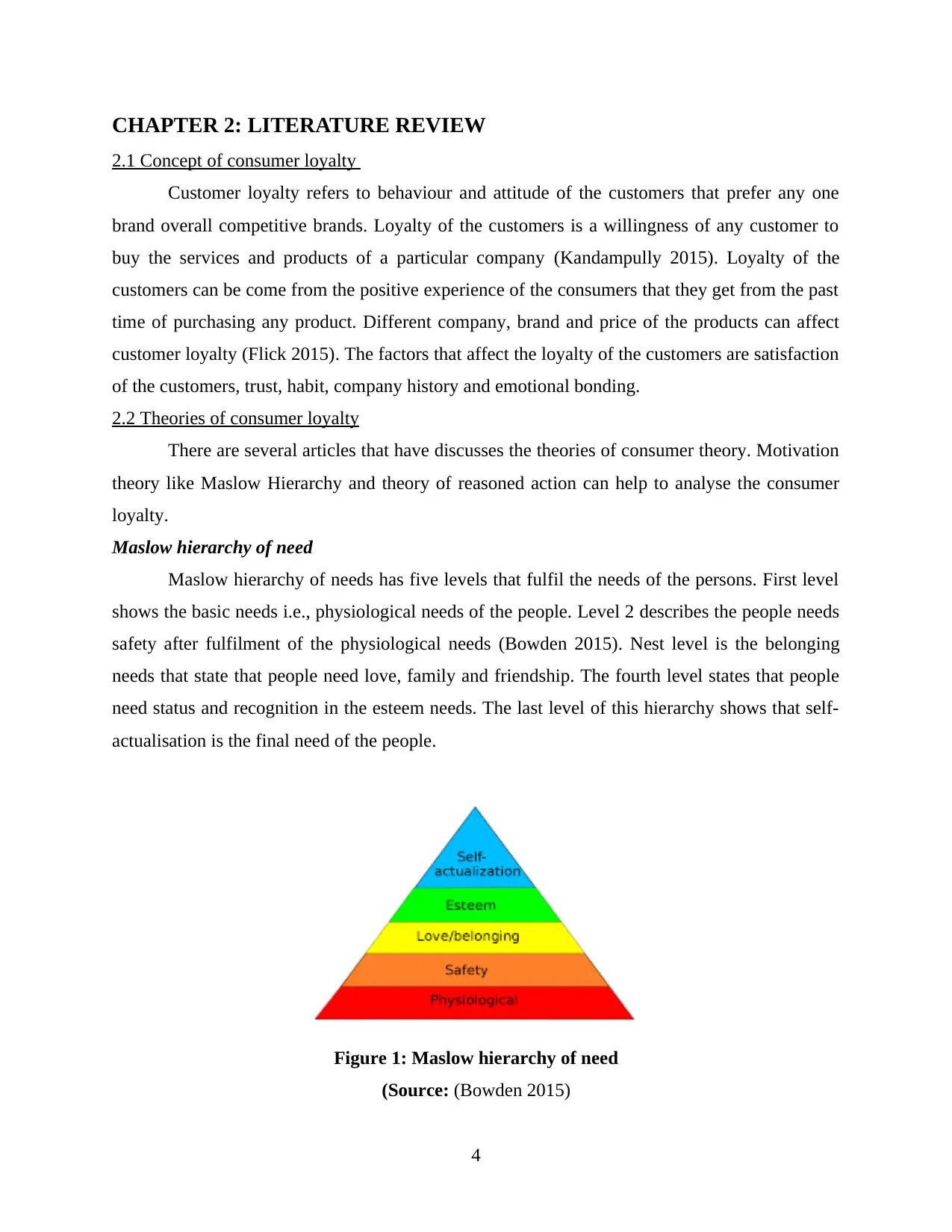
CHAPTER 2: LITERATURE REVIEW
2.1 Concept of consumer loyalty
Customer loyalty refers to behaviour and attitude of the customers that prefer any one
brand overall competitive brands. Loyalty of the customers is a willingness of any customer to
buy the services and products of a particular company (Kandampully 2015). Loyalty of the
customers can be come from the positive experience of the consumers that they get from the past
time of purchasing any product. Different company, brand and price of the products can affect
customer loyalty (Flick 2015). The factors that affect the loyalty of the customers are satisfaction
of the customers, trust, habit, company history and emotional bonding.
2.2 Theories of consumer loyalty
There are several articles that have discusses the theories of consumer theory. Motivation
theory like Maslow Hierarchy and theory of reasoned action can help to analyse the consumer
loyalty.
Maslow hierarchy of need
Maslow hierarchy of needs has five levels that fulfil the needs of the persons. First level
shows the basic needs i.e., physiological needs of the people. Level 2 describes the people needs
safety after fulfilment of the physiological needs (Bowden 2015). Nest level is the belonging
needs that state that people need love, family and friendship. The fourth level states that people
need status and recognition in the esteem needs. The last level of this hierarchy shows that self-
actualisation is the final need of the people.
Figure 1: Maslow hierarchy of need
(Source: (Bowden 2015)
4
2.1 Concept of consumer loyalty
Customer loyalty refers to behaviour and attitude of the customers that prefer any one
brand overall competitive brands. Loyalty of the customers is a willingness of any customer to
buy the services and products of a particular company (Kandampully 2015). Loyalty of the
customers can be come from the positive experience of the consumers that they get from the past
time of purchasing any product. Different company, brand and price of the products can affect
customer loyalty (Flick 2015). The factors that affect the loyalty of the customers are satisfaction
of the customers, trust, habit, company history and emotional bonding.
2.2 Theories of consumer loyalty
There are several articles that have discusses the theories of consumer theory. Motivation
theory like Maslow Hierarchy and theory of reasoned action can help to analyse the consumer
loyalty.
Maslow hierarchy of need
Maslow hierarchy of needs has five levels that fulfil the needs of the persons. First level
shows the basic needs i.e., physiological needs of the people. Level 2 describes the people needs
safety after fulfilment of the physiological needs (Bowden 2015). Nest level is the belonging
needs that state that people need love, family and friendship. The fourth level states that people
need status and recognition in the esteem needs. The last level of this hierarchy shows that self-
actualisation is the final need of the people.
Figure 1: Maslow hierarchy of need
(Source: (Bowden 2015)
4
Paraphrase This Document
Need a fresh take? Get an instant paraphrase of this document with our AI Paraphraser
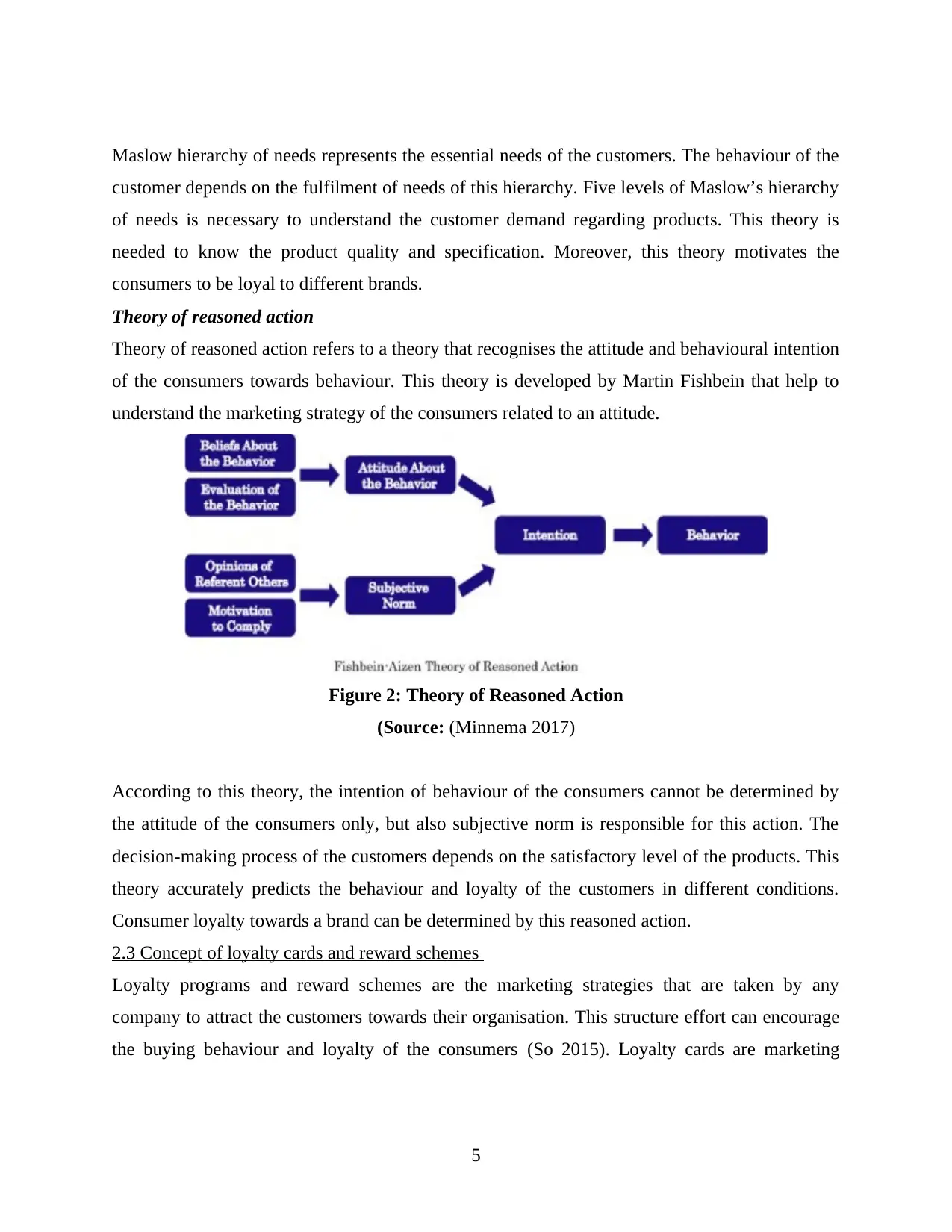
Maslow hierarchy of needs represents the essential needs of the customers. The behaviour of the
customer depends on the fulfilment of needs of this hierarchy. Five levels of Maslow’s hierarchy
of needs is necessary to understand the customer demand regarding products. This theory is
needed to know the product quality and specification. Moreover, this theory motivates the
consumers to be loyal to different brands.
Theory of reasoned action
Theory of reasoned action refers to a theory that recognises the attitude and behavioural intention
of the consumers towards behaviour. This theory is developed by Martin Fishbein that help to
understand the marketing strategy of the consumers related to an attitude.
Figure 2: Theory of Reasoned Action
(Source: (Minnema 2017)
According to this theory, the intention of behaviour of the consumers cannot be determined by
the attitude of the consumers only, but also subjective norm is responsible for this action. The
decision-making process of the customers depends on the satisfactory level of the products. This
theory accurately predicts the behaviour and loyalty of the customers in different conditions.
Consumer loyalty towards a brand can be determined by this reasoned action.
2.3 Concept of loyalty cards and reward schemes
Loyalty programs and reward schemes are the marketing strategies that are taken by any
company to attract the customers towards their organisation. This structure effort can encourage
the buying behaviour and loyalty of the consumers (So 2015). Loyalty cards are marketing
5
customer depends on the fulfilment of needs of this hierarchy. Five levels of Maslow’s hierarchy
of needs is necessary to understand the customer demand regarding products. This theory is
needed to know the product quality and specification. Moreover, this theory motivates the
consumers to be loyal to different brands.
Theory of reasoned action
Theory of reasoned action refers to a theory that recognises the attitude and behavioural intention
of the consumers towards behaviour. This theory is developed by Martin Fishbein that help to
understand the marketing strategy of the consumers related to an attitude.
Figure 2: Theory of Reasoned Action
(Source: (Minnema 2017)
According to this theory, the intention of behaviour of the consumers cannot be determined by
the attitude of the consumers only, but also subjective norm is responsible for this action. The
decision-making process of the customers depends on the satisfactory level of the products. This
theory accurately predicts the behaviour and loyalty of the customers in different conditions.
Consumer loyalty towards a brand can be determined by this reasoned action.
2.3 Concept of loyalty cards and reward schemes
Loyalty programs and reward schemes are the marketing strategies that are taken by any
company to attract the customers towards their organisation. This structure effort can encourage
the buying behaviour and loyalty of the consumers (So 2015). Loyalty cards are marketing
5
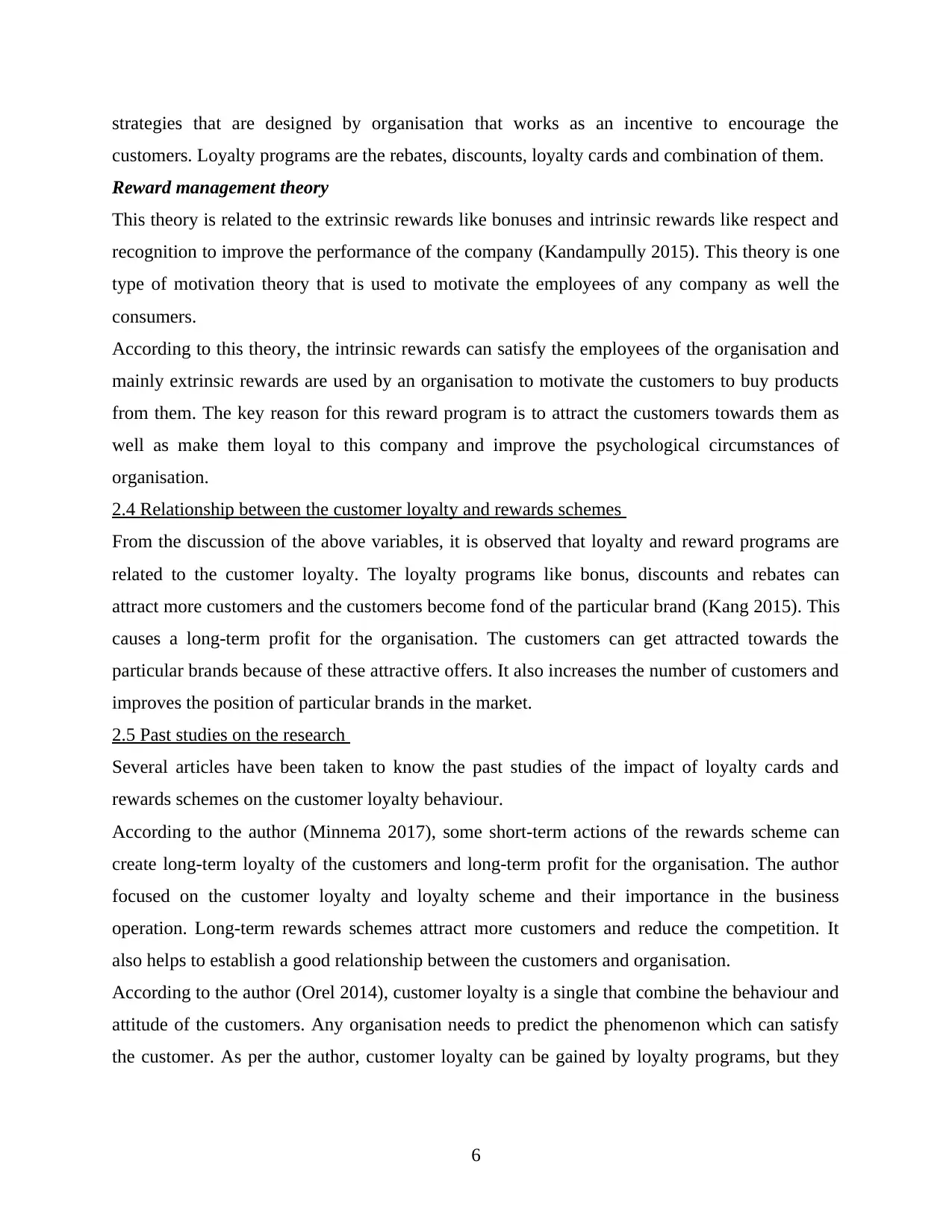
strategies that are designed by organisation that works as an incentive to encourage the
customers. Loyalty programs are the rebates, discounts, loyalty cards and combination of them.
Reward management theory
This theory is related to the extrinsic rewards like bonuses and intrinsic rewards like respect and
recognition to improve the performance of the company (Kandampully 2015). This theory is one
type of motivation theory that is used to motivate the employees of any company as well the
consumers.
According to this theory, the intrinsic rewards can satisfy the employees of the organisation and
mainly extrinsic rewards are used by an organisation to motivate the customers to buy products
from them. The key reason for this reward program is to attract the customers towards them as
well as make them loyal to this company and improve the psychological circumstances of
organisation.
2.4 Relationship between the customer loyalty and rewards schemes
From the discussion of the above variables, it is observed that loyalty and reward programs are
related to the customer loyalty. The loyalty programs like bonus, discounts and rebates can
attract more customers and the customers become fond of the particular brand (Kang 2015). This
causes a long-term profit for the organisation. The customers can get attracted towards the
particular brands because of these attractive offers. It also increases the number of customers and
improves the position of particular brands in the market.
2.5 Past studies on the research
Several articles have been taken to know the past studies of the impact of loyalty cards and
rewards schemes on the customer loyalty behaviour.
According to the author (Minnema 2017), some short-term actions of the rewards scheme can
create long-term loyalty of the customers and long-term profit for the organisation. The author
focused on the customer loyalty and loyalty scheme and their importance in the business
operation. Long-term rewards schemes attract more customers and reduce the competition. It
also helps to establish a good relationship between the customers and organisation.
According to the author (Orel 2014), customer loyalty is a single that combine the behaviour and
attitude of the customers. Any organisation needs to predict the phenomenon which can satisfy
the customer. As per the author, customer loyalty can be gained by loyalty programs, but they
6
customers. Loyalty programs are the rebates, discounts, loyalty cards and combination of them.
Reward management theory
This theory is related to the extrinsic rewards like bonuses and intrinsic rewards like respect and
recognition to improve the performance of the company (Kandampully 2015). This theory is one
type of motivation theory that is used to motivate the employees of any company as well the
consumers.
According to this theory, the intrinsic rewards can satisfy the employees of the organisation and
mainly extrinsic rewards are used by an organisation to motivate the customers to buy products
from them. The key reason for this reward program is to attract the customers towards them as
well as make them loyal to this company and improve the psychological circumstances of
organisation.
2.4 Relationship between the customer loyalty and rewards schemes
From the discussion of the above variables, it is observed that loyalty and reward programs are
related to the customer loyalty. The loyalty programs like bonus, discounts and rebates can
attract more customers and the customers become fond of the particular brand (Kang 2015). This
causes a long-term profit for the organisation. The customers can get attracted towards the
particular brands because of these attractive offers. It also increases the number of customers and
improves the position of particular brands in the market.
2.5 Past studies on the research
Several articles have been taken to know the past studies of the impact of loyalty cards and
rewards schemes on the customer loyalty behaviour.
According to the author (Minnema 2017), some short-term actions of the rewards scheme can
create long-term loyalty of the customers and long-term profit for the organisation. The author
focused on the customer loyalty and loyalty scheme and their importance in the business
operation. Long-term rewards schemes attract more customers and reduce the competition. It
also helps to establish a good relationship between the customers and organisation.
According to the author (Orel 2014), customer loyalty is a single that combine the behaviour and
attitude of the customers. Any organisation needs to predict the phenomenon which can satisfy
the customer. As per the author, customer loyalty can be gained by loyalty programs, but they
6
⊘ This is a preview!⊘
Do you want full access?
Subscribe today to unlock all pages.

Trusted by 1+ million students worldwide
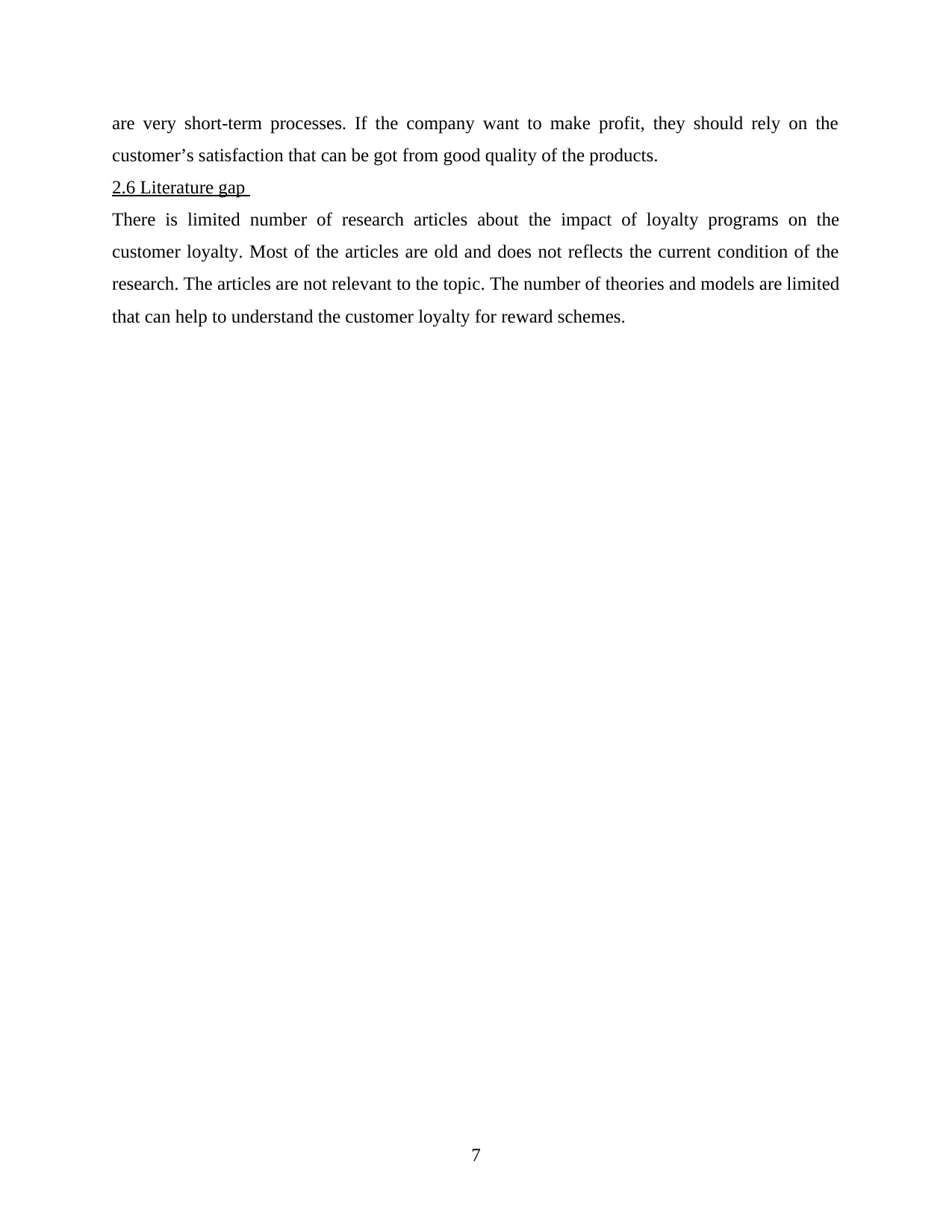
are very short-term processes. If the company want to make profit, they should rely on the
customer’s satisfaction that can be got from good quality of the products.
2.6 Literature gap
There is limited number of research articles about the impact of loyalty programs on the
customer loyalty. Most of the articles are old and does not reflects the current condition of the
research. The articles are not relevant to the topic. The number of theories and models are limited
that can help to understand the customer loyalty for reward schemes.
7
customer’s satisfaction that can be got from good quality of the products.
2.6 Literature gap
There is limited number of research articles about the impact of loyalty programs on the
customer loyalty. Most of the articles are old and does not reflects the current condition of the
research. The articles are not relevant to the topic. The number of theories and models are limited
that can help to understand the customer loyalty for reward schemes.
7
Paraphrase This Document
Need a fresh take? Get an instant paraphrase of this document with our AI Paraphraser
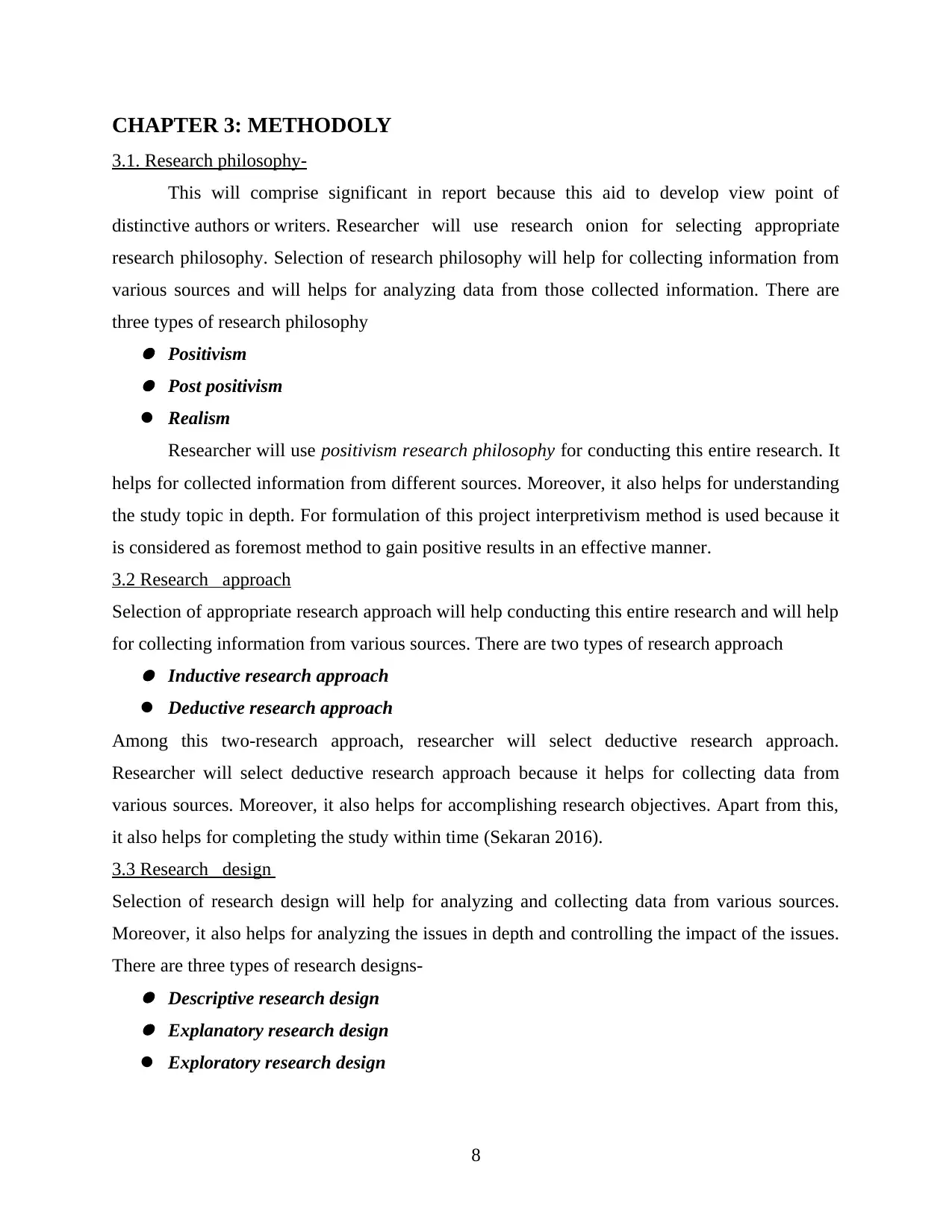
CHAPTER 3: METHODOLY
3.1. Research philosophy-
This will comprise significant in report because this aid to develop view point of
distinctive authors or writers. Researcher will use research onion for selecting appropriate
research philosophy. Selection of research philosophy will help for collecting information from
various sources and will helps for analyzing data from those collected information. There are
three types of research philosophy Positivism Post positivism
Realism
Researcher will use positivism research philosophy for conducting this entire research. It
helps for collected information from different sources. Moreover, it also helps for understanding
the study topic in depth. For formulation of this project interpretivism method is used because it
is considered as foremost method to gain positive results in an effective manner.
3.2 Research approach
Selection of appropriate research approach will help conducting this entire research and will help
for collecting information from various sources. There are two types of research approach Inductive research approach
Deductive research approach
Among this two-research approach, researcher will select deductive research approach.
Researcher will select deductive research approach because it helps for collecting data from
various sources. Moreover, it also helps for accomplishing research objectives. Apart from this,
it also helps for completing the study within time (Sekaran 2016).
3.3 Research design
Selection of research design will help for analyzing and collecting data from various sources.
Moreover, it also helps for analyzing the issues in depth and controlling the impact of the issues.
There are three types of research designs- Descriptive research design Explanatory research design
Exploratory research design
8
3.1. Research philosophy-
This will comprise significant in report because this aid to develop view point of
distinctive authors or writers. Researcher will use research onion for selecting appropriate
research philosophy. Selection of research philosophy will help for collecting information from
various sources and will helps for analyzing data from those collected information. There are
three types of research philosophy Positivism Post positivism
Realism
Researcher will use positivism research philosophy for conducting this entire research. It
helps for collected information from different sources. Moreover, it also helps for understanding
the study topic in depth. For formulation of this project interpretivism method is used because it
is considered as foremost method to gain positive results in an effective manner.
3.2 Research approach
Selection of appropriate research approach will help conducting this entire research and will help
for collecting information from various sources. There are two types of research approach Inductive research approach
Deductive research approach
Among this two-research approach, researcher will select deductive research approach.
Researcher will select deductive research approach because it helps for collecting data from
various sources. Moreover, it also helps for accomplishing research objectives. Apart from this,
it also helps for completing the study within time (Sekaran 2016).
3.3 Research design
Selection of research design will help for analyzing and collecting data from various sources.
Moreover, it also helps for analyzing the issues in depth and controlling the impact of the issues.
There are three types of research designs- Descriptive research design Explanatory research design
Exploratory research design
8
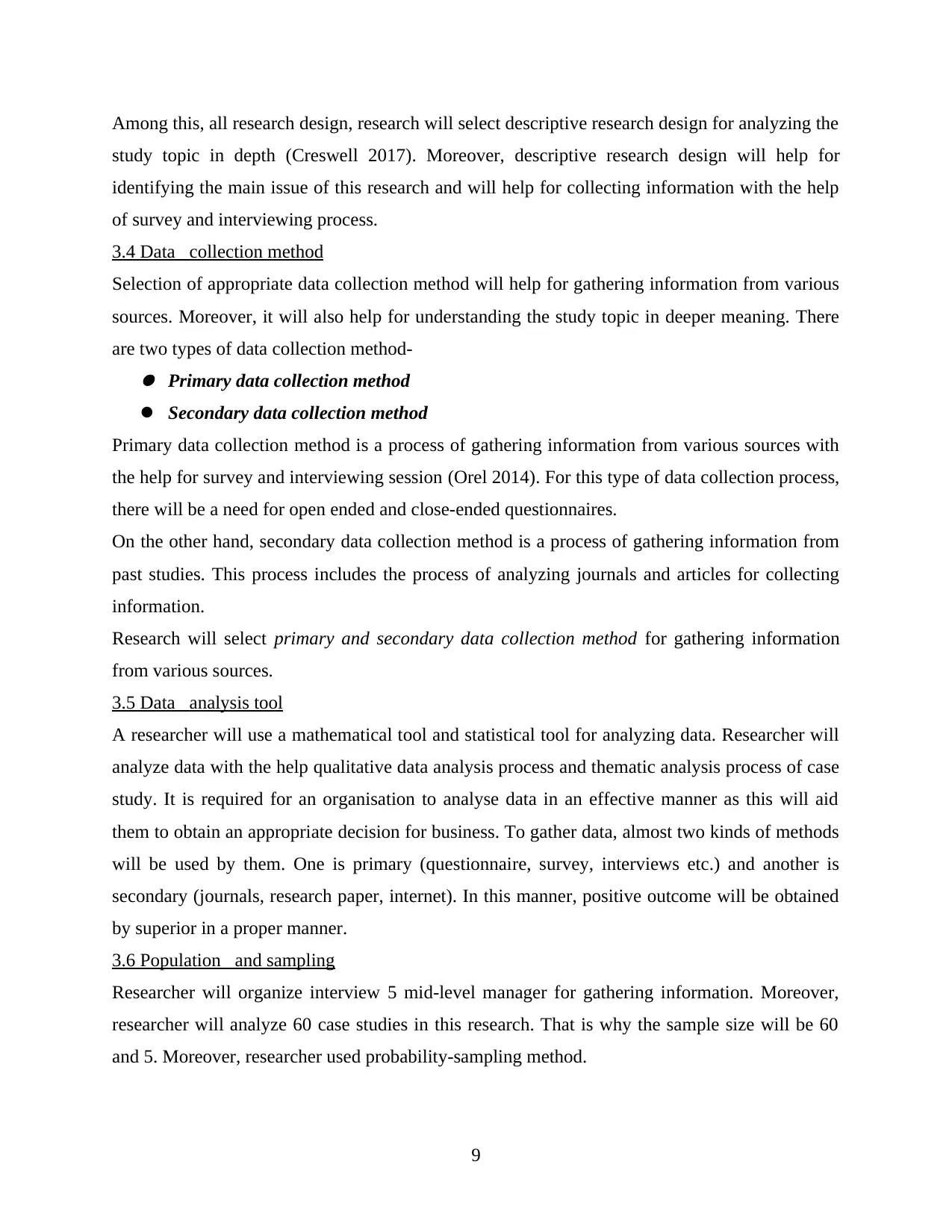
Among this, all research design, research will select descriptive research design for analyzing the
study topic in depth (Creswell 2017). Moreover, descriptive research design will help for
identifying the main issue of this research and will help for collecting information with the help
of survey and interviewing process.
3.4 Data collection method
Selection of appropriate data collection method will help for gathering information from various
sources. Moreover, it will also help for understanding the study topic in deeper meaning. There
are two types of data collection method- Primary data collection method
Secondary data collection method
Primary data collection method is a process of gathering information from various sources with
the help for survey and interviewing session (Orel 2014). For this type of data collection process,
there will be a need for open ended and close-ended questionnaires.
On the other hand, secondary data collection method is a process of gathering information from
past studies. This process includes the process of analyzing journals and articles for collecting
information.
Research will select primary and secondary data collection method for gathering information
from various sources.
3.5 Data analysis tool
A researcher will use a mathematical tool and statistical tool for analyzing data. Researcher will
analyze data with the help qualitative data analysis process and thematic analysis process of case
study. It is required for an organisation to analyse data in an effective manner as this will aid
them to obtain an appropriate decision for business. To gather data, almost two kinds of methods
will be used by them. One is primary (questionnaire, survey, interviews etc.) and another is
secondary (journals, research paper, internet). In this manner, positive outcome will be obtained
by superior in a proper manner.
3.6 Population and sampling
Researcher will organize interview 5 mid-level manager for gathering information. Moreover,
researcher will analyze 60 case studies in this research. That is why the sample size will be 60
and 5. Moreover, researcher used probability-sampling method.
9
study topic in depth (Creswell 2017). Moreover, descriptive research design will help for
identifying the main issue of this research and will help for collecting information with the help
of survey and interviewing process.
3.4 Data collection method
Selection of appropriate data collection method will help for gathering information from various
sources. Moreover, it will also help for understanding the study topic in deeper meaning. There
are two types of data collection method- Primary data collection method
Secondary data collection method
Primary data collection method is a process of gathering information from various sources with
the help for survey and interviewing session (Orel 2014). For this type of data collection process,
there will be a need for open ended and close-ended questionnaires.
On the other hand, secondary data collection method is a process of gathering information from
past studies. This process includes the process of analyzing journals and articles for collecting
information.
Research will select primary and secondary data collection method for gathering information
from various sources.
3.5 Data analysis tool
A researcher will use a mathematical tool and statistical tool for analyzing data. Researcher will
analyze data with the help qualitative data analysis process and thematic analysis process of case
study. It is required for an organisation to analyse data in an effective manner as this will aid
them to obtain an appropriate decision for business. To gather data, almost two kinds of methods
will be used by them. One is primary (questionnaire, survey, interviews etc.) and another is
secondary (journals, research paper, internet). In this manner, positive outcome will be obtained
by superior in a proper manner.
3.6 Population and sampling
Researcher will organize interview 5 mid-level manager for gathering information. Moreover,
researcher will analyze 60 case studies in this research. That is why the sample size will be 60
and 5. Moreover, researcher used probability-sampling method.
9
⊘ This is a preview!⊘
Do you want full access?
Subscribe today to unlock all pages.

Trusted by 1+ million students worldwide
1 out of 25
Related Documents
Your All-in-One AI-Powered Toolkit for Academic Success.
+13062052269
info@desklib.com
Available 24*7 on WhatsApp / Email
![[object Object]](/_next/static/media/star-bottom.7253800d.svg)
Unlock your academic potential
Copyright © 2020–2025 A2Z Services. All Rights Reserved. Developed and managed by ZUCOL.





